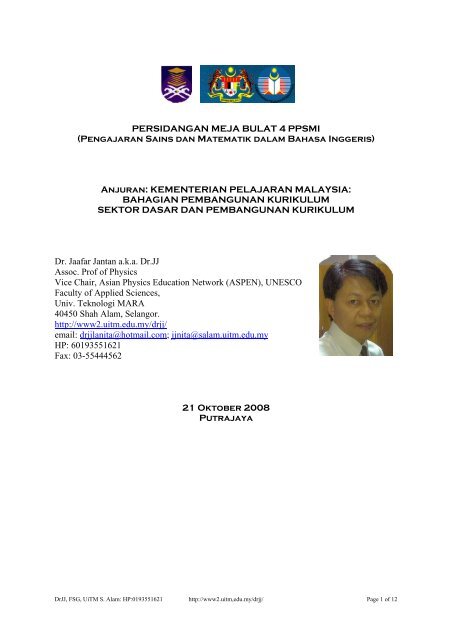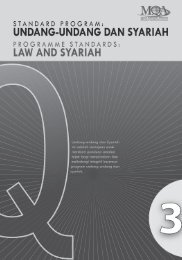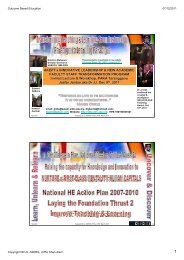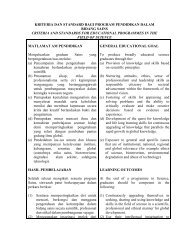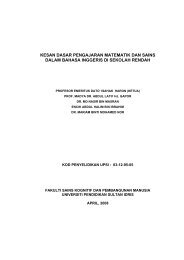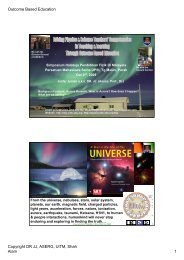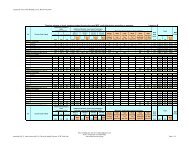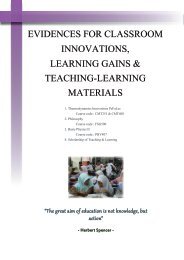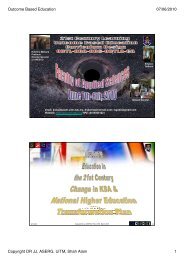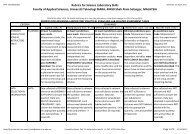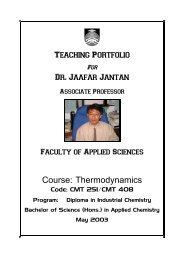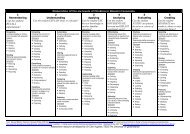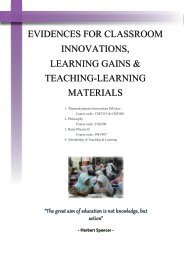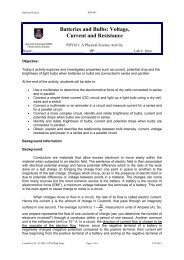DrJJ PPSMI article 011008.pdf - Dr JJ or Dr Jaafar Jantan Homepage
DrJJ PPSMI article 011008.pdf - Dr JJ or Dr Jaafar Jantan Homepage
DrJJ PPSMI article 011008.pdf - Dr JJ or Dr Jaafar Jantan Homepage
Create successful ePaper yourself
Turn your PDF publications into a flip-book with our unique Google optimized e-Paper software.
PERSIDANGAN MEJA BULAT 4 <strong>PPSMI</strong><br />
(Pengajaran Sains dan Matematik dalam Bahasa Inggeris)<br />
Anjuran: KEMENTERIAN PELAJARAN MALAYSIA:<br />
BAHAGIAN PEMBANGUNAN KURIKULUM<br />
SEKTOR DASAR DAN PEMBANGUNAN KURIKULUM<br />
<strong>Dr</strong>. <strong>Jaafar</strong> <strong>Jantan</strong> a.k.a. <strong>Dr</strong>.<strong>JJ</strong><br />
Assoc. Prof of Physics<br />
Vice Chair, Asian Physics Education Netw<strong>or</strong>k (ASPEN), UNESCO<br />
Faculty of Applied Sciences,<br />
Univ. Teknologi MARA<br />
40450 Shah Alam, Selang<strong>or</strong>.<br />
http://www2.uitm.edu.my/drjj/<br />
email: drjjlanita@hotmail.com; jjnita@salam.uitm.edu.my<br />
HP: 60193551621<br />
Fax: 03-55444562<br />
21 Oktober 2008<br />
Putrajaya<br />
<strong><strong>Dr</strong><strong>JJ</strong></strong>, FSG, UiTM S. Alam: HP:0193551621 http://www2.uitm,edu.my/drjj/ Page 1 of 12
The Scenario<br />
The Teaching and Learning of Science and Mathematics in English <strong>or</strong> <strong>PPSMI</strong> is now<br />
being seriously debated by academicians, representatives of the non-governmental<br />
<strong>or</strong>ganizations (NGOs), policy makers and the public at large. Central to the discussion is the<br />
use of English as a medium of instruction in the teaching of science and math at both the<br />
primary schools and secondary schools in Malaysia. The issue is whether <strong>PPSMI</strong>, which was<br />
implemented in January 2003, has improved not only the English proficiency among pupils<br />
but most imp<strong>or</strong>tantly the learning and the achievement level of science and math. At stake<br />
now is whether <strong>PPSMI</strong> should be allowed to continue in its present f<strong>or</strong>mat, terminated <strong>or</strong><br />
changed to a different m<strong>or</strong>e receptive and acceptable f<strong>or</strong>mat.<br />
The <strong>PPSMI</strong> debate began when the findings of an impact assessment rep<strong>or</strong>t on the use<br />
of English f<strong>or</strong> the Teaching and Learning of Math and Science at primary schools were made<br />
public by researchers at Universiti Perguruan Sultan Idris (UPSI). Primarily, the researchers<br />
published a volume of statistical inf<strong>or</strong>mation on the survey and tests that the researchers did<br />
on 68 primary schools from February 2007 to January 2008. One thousand five hundred and<br />
sixty four Year 5 pupils participated in Feb 2007, 636 Year 5 pupils in July 2007 and 1,703<br />
Year 5 pupils in Jan 2008. The findings and the conclusion had prompted many quarters to<br />
voice their views on the <strong>PPSMI</strong>. I take this opp<strong>or</strong>tunity to comment on the conclusion of the<br />
study and to offer an alternative view from the perspective of a public university educat<strong>or</strong>.<br />
Even though the results from the study did not scientifically show that the use of<br />
English as a medium of instruction in Science and Math led to low achievement of science<br />
and math f<strong>or</strong> the Year 5 pupils, the auth<strong>or</strong>s of the study led by Prof. Ishak Haron, an emeritus<br />
profess<strong>or</strong>, claimed that <strong>PPSMI</strong> has failed to achieve its purpose and hence a reversal of the<br />
policy must be made. The call f<strong>or</strong> a reversal in the <strong>PPSMI</strong> policy as was rep<strong>or</strong>ted by local<br />
media is strongly supp<strong>or</strong>ted by a few politicians, prominent academicians and NGOs. As a<br />
practicing science educat<strong>or</strong> who has indulged in science and physics education research and<br />
who is actively involved in the training of using active learning strategies to science and<br />
physics educat<strong>or</strong>s locally and internationally f<strong>or</strong> the past 16 years, I strongly disagree with<br />
both the conclusion of the findings and the call f<strong>or</strong> a reversal of the <strong>PPSMI</strong> policy.<br />
I argue that the arguments given in the study is invalid because the research design is<br />
flawed and that the auth<strong>or</strong>s of the study were making plenty of conjectures (unfounded<br />
claims) in arriving at their call f<strong>or</strong> a reversal of the <strong>PPSMI</strong> policy.<br />
Flaws of the Research Design<br />
The research employed by the study is a descriptive research which means that the<br />
study did not offer any kind of hypothesis that can be tested <strong>or</strong> falsified. The second part of<br />
the study tried to establish a c<strong>or</strong>relation between mean sc<strong>or</strong>es of science and math test with<br />
the frequencies (percentage) obtained from surveys on <strong>PPSMI</strong> practices. F<strong>or</strong> the benefit of<br />
the reader, descriptive research employs the use of surveys and questionnaires to<br />
systematically observe and rec<strong>or</strong>d data without manipulation of the observed phenomenon.<br />
On the other hand, c<strong>or</strong>relational research is done to identify apparent relationships between<br />
two variables <strong>or</strong> fact<strong>or</strong>s. Although the auth<strong>or</strong>s did not mention the two types of research<br />
methods they are employing in their methodology section but readers are reminded of the two<br />
types of research method which is typical in social sciences. Using questionnaires, the<br />
researchers at UPSI were observing the percentages of teachers using English in teaching<br />
<strong><strong>Dr</strong><strong>JJ</strong></strong>, FSG, UiTM S. Alam: HP:0193551621 http://www2.uitm,edu.my/drjj/ Page 2 of 12
science and math, the percentages of students who are able to “follow” the teaching and the<br />
percentages of students who “understand” teachers who teach science and math in English.<br />
Unf<strong>or</strong>tunately, knowing the percentage of teachers using English only <strong>or</strong> using a<br />
mixture of English and Bahasa Malaysia (BM) in their teaching, will not, in any way, be<br />
c<strong>or</strong>related to either achievement of pupils in science and math <strong>or</strong> the increase in English<br />
proficiency among pupils after 4 years of <strong>PPSMI</strong>. However, it does give the reader a<br />
quantitative picture of the comf<strong>or</strong>t level of teachers <strong>or</strong> the lack of and the concern of teachers<br />
on students’ “uneasiness” during the classroom learning activities.<br />
My concern with the auth<strong>or</strong>s’ choice on the concept of “easy to learn”, “hard to<br />
learn” and “understand” is that none of the concepts are behavi<strong>or</strong>ally measurable and the<br />
auth<strong>or</strong>s never operationally define the concepts in their methodology. Since “easy” and<br />
“hard” are relative and the reference point is not defined, the term “easy” f<strong>or</strong> one pupil could<br />
sometimes be hard to another. Hence, the use of “easy to learn” <strong>or</strong> “hard to learn” cannot<br />
be considered a significantly meaningful variable and the percentages of the frequency f<strong>or</strong><br />
those two variables cannot be conceived to be meaningful in associating the use of English to<br />
teach science and math to the pupils’ actual learning of the subject matter. Theref<strong>or</strong>e, using<br />
this variable to argue f<strong>or</strong> the reversal of <strong>PPSMI</strong> is invalid and not logical.<br />
The term “understand” suffers the same fate since understand is an abstract w<strong>or</strong>d.<br />
Could it be referring to comprehending and knowing what was said <strong>or</strong> could it refer to<br />
experiencing meaningful learning of the subject matter In addition, one pupil’s<br />
“understand” could as well be “always understand” f<strong>or</strong> another pupil. Since “understand”<br />
was not operationally defined and the reference point was never described in the<br />
methodology section, the frequency percentages f<strong>or</strong> this variable cannot be conceived to be<br />
meaningful in associating the use of English to teach science and math to the pupils’ actual<br />
learning of the subject matter. Hence, using this variable to argue f<strong>or</strong> the reversal of <strong>PPSMI</strong> is<br />
invalid and not logical. It would have been m<strong>or</strong>e meaningful to replace the term<br />
“understand” with a few measurable verbs such as distinguish, describe and write, classify,<br />
<strong>or</strong>ganize, argue, reason, suggest, state and draw.<br />
The math and science tests used f<strong>or</strong> determining the achievement of science and math<br />
in the study are not standard instruments. The tests were never piloted (no mention was made<br />
in the methodology) and the auth<strong>or</strong>s failed to describe how the instruments were constructed<br />
and tested f<strong>or</strong> validity and reliability except to say that the items were created by the auth<strong>or</strong>s.<br />
Since the blueprint of the test construction was never described and the validity and reliability<br />
were never ascertained, the w<strong>or</strong>thiness of the instruments in determining achievement in<br />
science and math is questionable. Hence using the mean sc<strong>or</strong>es from these tests to claim that<br />
<strong>PPSMI</strong> is a failure is illogical and invalid. Note that any scientific research must be<br />
repeatable by any interested parties in <strong>or</strong>der to be accepted as a scientific research.<br />
Conjectures<br />
The research on <strong>PPSMI</strong> cited by the auth<strong>or</strong>s in the rep<strong>or</strong>t were also of descriptive<br />
research and most did not discuss on the validity and reliability of their instruments and none<br />
really did any kind of experiment with well-defined variables on understanding <strong>or</strong> meaningful<br />
learning. Hence, the conclusion that they arrived at are not justified. Prof. Ishak Haron’s team<br />
made a lot of conjectures (claim without supp<strong>or</strong>tive evidence) in their rep<strong>or</strong>t. They claimed,<br />
on page 38 of their rep<strong>or</strong>t, that one of the reasons why Malay pupils are weak in science and<br />
<strong><strong>Dr</strong><strong>JJ</strong></strong>, FSG, UiTM S. Alam: HP:0193551621 http://www2.uitm,edu.my/drjj/ Page 3 of 12
math is because the pupils are not proficient in English and that they were unable to<br />
“understand” the teaching of their teachers in English. The researchers arrived at this<br />
conclusion from results of the research’s survey that teachers use a mixture of English and<br />
Bahasa Malaysia and a significantly large percentage of the students claimed that they do not<br />
“understand” science and math taught in English. Was there really any hard evidence from<br />
the survey to indicate that language proficiency, especially English, caused pupils of <strong>PPSMI</strong><br />
to be weak in science and math The observations made were;<br />
teachers used English <strong>or</strong> a mixture of English and BM in the teaching of science and<br />
math and<br />
students claimed that they “do not understand” <strong>or</strong> only “sometimes understand” the<br />
teaching of science and math in English.<br />
Based on these observations (obtained from the survey), the auth<strong>or</strong>s’ conclusion remains<br />
only as a conjecture and the argument given is invalid since the conclusion has no<br />
association with any of the 2 premises <strong>or</strong> observations made. In other w<strong>or</strong>ds, their the<strong>or</strong>y that<br />
English language proficiency (<strong>or</strong> lack of) caused pupils to be weak in science and math based<br />
only on the two premises is inductively invalid.<br />
In addition to the invalid argument made about language proficiency and being weak in<br />
science and math, there are a number of other glaringly invalid arguments made on page 48<br />
of the rep<strong>or</strong>t:<br />
Pupils cannot understand and think about math and science concepts in English due to<br />
the lack of proficiency in English<br />
Malay pupils can easily understand and think about math and science’s technical<br />
concepts in BM because they are proficient in BM.<br />
Teaching in BM is easier to understand.<br />
Pupils easily read and understand references f<strong>or</strong> science and math in Bahasa<br />
Malaysia.<br />
70% of Malay students will not master concepts and knowledge in math and science<br />
in the long run (upper secondary and tertiary level).<br />
F<strong>or</strong> all the claims above, the auth<strong>or</strong>s did not make any f<strong>or</strong>m of quantitative <strong>or</strong> qualitative<br />
measurement to supp<strong>or</strong>t the claims. They are just mere speculations. In fact, the auth<strong>or</strong>s were<br />
bold enough to make a prediction that 70% of Malay students will not master concepts and<br />
knowledge in the long run, a prediction based on conjectures and invalid arguments.<br />
Chapter 4 and 5 of the rep<strong>or</strong>t discussed the sc<strong>or</strong>es of math and science tests and the<br />
mean sc<strong>or</strong>e f<strong>or</strong> each item were c<strong>or</strong>related to percentages of students who found it “hard to<br />
follow” and “understand” science and math in English. While the low mean sc<strong>or</strong>es f<strong>or</strong> the<br />
tests inf<strong>or</strong>med the readers on the low achievement of the pupils, the cause of that was not<br />
ascertained. In other w<strong>or</strong>ds, the claim that there is a positive c<strong>or</strong>relation f<strong>or</strong> “hard to follow”<br />
and “understand” teaching in English and the mean sc<strong>or</strong>e of the tests is unfounded and must<br />
be rejected. Furtherm<strong>or</strong>e, the instrument itself has not been shown to be valid and reliable by<br />
the auth<strong>or</strong>s (none was discussed in the methodology). Science relies heavily on the validity<br />
and reliability of the instruments used to make measurements and hence make science biasfree.<br />
The hypothesis <strong>or</strong> claim that the low mean sc<strong>or</strong>es is due to “hard to follow” <strong>or</strong><br />
“understand” science and math taught in English could probably have been tested by a<br />
number of interventions in the f<strong>or</strong>m of learning activities. In addition, the tests should include<br />
questions both in English and BM that address the same assessment outcomes. Since this was<br />
not done, hence the hypothesis that low mean sc<strong>or</strong>e on the science and math tests is caused by<br />
<strong><strong>Dr</strong><strong>JJ</strong></strong>, FSG, UiTM S. Alam: HP:0193551621 http://www2.uitm,edu.my/drjj/ Page 4 of 12
students finding it “hard to follow” and “understand” the science and math in English must<br />
be rejected.<br />
My Arguments<br />
My arguments above focused on the flawed research design by the auth<strong>or</strong>s and hence<br />
their conclusion and suggestion that <strong>PPSMI</strong> is a failure must be rejected. The auth<strong>or</strong>s, being<br />
in the cognitive science, may find it instructive to refer to the volumes of research published<br />
regarding difficulties in the learning of science and math. I suggest reading some <strong>article</strong>s<br />
written by researchers in science education, physics education, engineering education,<br />
chemical education, biology education and math education in helping them design a valid and<br />
reliable survey and invent<strong>or</strong>y instruments. The standardized aptitude tests (psychometric)<br />
which measure arithmetic, science reasoning skills, verbal and comprehension would be a<br />
good start f<strong>or</strong> the auth<strong>or</strong>s to consider using in any follow up studies. Tests that measure<br />
motivation could also be used to determine if teaching in English motivates students to learn<br />
science, mathematics and English. In addition, I suggest that the auth<strong>or</strong>s take extra measures<br />
to distinguish between a valid and an invalid argument using science as a tool to confirm <strong>or</strong><br />
refute the truth of an argument.<br />
Even though there are some flaws to the research design and the conclusion, the<br />
rep<strong>or</strong>t serves as an eye opener to me and to the public about the current state of affairs of<br />
<strong>PPSMI</strong>, five years down the road. F<strong>or</strong>tunately, all is not lost. Since the purpose of <strong>PPSMI</strong> is<br />
to strengthen the foundation in <strong>or</strong>der to obtain inf<strong>or</strong>mation, facts and knowledge in science<br />
and math by improving students’ proficiency in English, then <strong>PPSMI</strong> may just need to be<br />
reviewed in ways that it is being implemented.<br />
As suggested by NUTP in an <strong>article</strong> published by the New Straits Times in September<br />
08, English needs to be strengthened during the first four years of a child’s education<br />
(kindergarten till Year 3) bef<strong>or</strong>e f<strong>or</strong>mally introducing science and math in English. Instead of<br />
teaching science and math in English at this level, the science and math activities can be<br />
embedded in the English subject. This means that the contact hours f<strong>or</strong> English may need to<br />
be increased by three-fold. Prof DiRaja Ungku Aziz and NUTP suggested introducing and<br />
strengthening the English grammar and w<strong>or</strong>d pronunciations. In addition, I suggest that<br />
pupils at this level be given the experience to develop their writing and <strong>or</strong>al skills. The<br />
playful and inquisitive nature of the pupils at this level demands that classroom learning<br />
activities be focused m<strong>or</strong>e on active participation and involvement by the pupils.<br />
Success in increasing <strong>or</strong> improving English proficiency at this level is best done<br />
through active learning such as drama, acting out and role playing in the classroom (which I<br />
presume without any proof, has and is being done by many concerned teachers). There are<br />
plenty of research-based best practices that can be used in the classroom learning that will put<br />
the students at the center of learning. In fact, let us not f<strong>or</strong>get that Piaget categ<strong>or</strong>ized pupil’s<br />
intellectual skills at this stage, as preoperational (lacking logical operations) and early<br />
concrete operational level (beginning to think logically but based on concrete objects). I<br />
believe that Prof Ishak has m<strong>or</strong>e expertise to dwell on intellectual growth the<strong>or</strong>ies of Piaget,<br />
Brunner and Vygotsky and I believe that he can significantly contribute in the curriculum<br />
design (defining the learning outcomes and learning activities) appropriate f<strong>or</strong> this level.<br />
<strong>PPSMI</strong> must be allowed to continue. Billions of taxpayer’s money had been spent not<br />
only to train teachers to be proficient in English but also in supplying teaching and learning<br />
<strong><strong>Dr</strong><strong>JJ</strong></strong>, FSG, UiTM S. Alam: HP:0193551621 http://www2.uitm,edu.my/drjj/ Page 5 of 12
hardware and multimedia courseware to assist teachers in the classroom activities. It is<br />
unf<strong>or</strong>tunate that many teachers are still not proficient in English but then again, proficiency in<br />
any language requires continuous practice and requires a long time to master. Sh<strong>or</strong>t courses<br />
here and there will not guarantee proficiency and mastery. It has to be the teacher’s individual<br />
eff<strong>or</strong>t, the school’s buddy system and supp<strong>or</strong>t from the community complementing each other<br />
and a long time that will help teachers be m<strong>or</strong>e proficient in English. Proficiency breeds<br />
confidence and with confidence teachers will be m<strong>or</strong>e at ease to teach in English. Five years<br />
is too sh<strong>or</strong>t to show that both teachers and students are at ease listening to and begin to<br />
communicate and comprehend the English language and the science and math taught in<br />
English.<br />
Unf<strong>or</strong>tunately, English proficiency is not a ticket to ensure understanding in science<br />
and math. Researches in cognitive psychology had revealed how our brain w<strong>or</strong>ks in obtaining<br />
and retaining inf<strong>or</strong>mation and how this inf<strong>or</strong>mation eventually becomes knowledge. Since<br />
education is the change in cognitive, psychomot<strong>or</strong> and affective behaviour, research-based<br />
best teaching practices must be inc<strong>or</strong>p<strong>or</strong>ated into the <strong>PPSMI</strong> classrooms. In other w<strong>or</strong>ds,<br />
there must be alignment between learning outcomes, be it cognitive <strong>or</strong> psychomot<strong>or</strong> and the<br />
teaching and learning activities (instructional strategies) derived from research-based<br />
teaching and learning best practices using English as the medium of instruction. Since<br />
understanding of science and math depends so much on knowing the concepts and the ability<br />
to comprehend and apply the concepts, it is very imp<strong>or</strong>tant f<strong>or</strong> teachers to employ effective<br />
teaching and learning methods.<br />
It is imperative that all teachers must aim to be not only content expert but also<br />
pedagogical-content expert who is proficient in English and able to use technology and<br />
multimedia as tools f<strong>or</strong> effective learning. As the constructivists would argue, effective<br />
learning depends on present knowledge and new knowledge can only be generated <strong>or</strong><br />
integrated via cognitive conflicts which must be done by teachers through different<br />
instructional activities. Piaget conceptualizes this process as adapting the present mental<br />
structures <strong>or</strong> schemata via assimilation, accommodation and equilibration. If <strong>PPSMI</strong> is to be<br />
successful in serving its objectives, then its implementation requires that teachers use the<br />
research-based teaching and learning best practices. Oppositions to <strong>PPSMI</strong> must realize that<br />
English proficiency is only the tip of the iceberg in promoting meaningful learning and<br />
improving the achievement of science and math at all levels of education.<br />
University Students’ English Proficiency<br />
Presently, the written and verbal abilities in English of my baccalaureate students who<br />
are from the non <strong>PPSMI</strong> coh<strong>or</strong>ts, is very depressing. Presented below are samples of a tenminute<br />
composition, from my philosophy science students when they were asked to write<br />
(they do compositions every end of class to confirm their class attendance) about their beliefs<br />
in their area of study. The spelling, grammatical err<strong>or</strong>s and the articulation <strong>or</strong> reasoning<br />
abilities shown by each student have been preserved and underlined f<strong>or</strong> you to observe. Note<br />
that the samples are representatives of the coh<strong>or</strong>t.<br />
Student A is maj<strong>or</strong>ing in Physics and is now in semester 5:<br />
My belief is solar energy can be a vital part as a sources of energy in the future. This<br />
is because there are always sun until the end of the days. With increasing of cost in<br />
our daily life, nowadays people are trying to cut off their expenses in <strong>or</strong>der to ensure<br />
<strong><strong>Dr</strong><strong>JJ</strong></strong>, FSG, UiTM S. Alam: HP:0193551621 http://www2.uitm,edu.my/drjj/ Page 6 of 12
their future life are safe. Sources such as oil will be finish at once day. So, it no<br />
longer will help us supply the energy such as in automotif field. So, we need some<br />
sources that remains till the ends of the days that is the sun. The energy of the sun can<br />
be converted to electrical energy and so on. Theref<strong>or</strong>e, I belief that solar energy<br />
played a vital sourced to the future.<br />
Student B is also maj<strong>or</strong>ing in Physics and is now in semester 5:<br />
I belief that the gravitational f<strong>or</strong>ce was exist. F<strong>or</strong> the argument, when the something<br />
such as apple was falling from the tree to the ground, there was gravitational f<strong>or</strong>ce<br />
exist. Besides that, because of the gravitational f<strong>or</strong>ce, people can walking, running,<br />
sitting and so on. Compare to the situation at the moon, there no gravitational f<strong>or</strong>ce,<br />
so that people that visit the moon, was floating.<br />
Student C is also maj<strong>or</strong>ing in Physics and is now in semester 5:<br />
I beliefs that Neil Armstrong do not arive in the moon in 1964. It because this year<br />
(2008) after 44 years after that, there has no people can reach the moon, with<br />
advance technology and machine compare in year of 1964.<br />
Student D is maj<strong>or</strong>ing in Food Technology and is now in semester 3:<br />
I believe that anything <strong>or</strong> things that we don’t assume can’t be consumed through out<br />
the innovation of food technology. The waste of food from the preparation bef<strong>or</strong>e cook<br />
may contain the same nutrient as the food we cook and consume. That means, we can<br />
budget our day life expences through thin innovation and reduce waste.<br />
F<strong>or</strong> an example, the innovation in pineapple skin can be converted to the nata de<br />
coco. The product also have the pharmacuetical/properties. Thus from this believe,<br />
may be one day I also can make the grass edible to be as human food. Hence, I can<br />
change the human perception about thing that we assumed as a waste but it is became<br />
our main food.<br />
F<strong>or</strong> the same course and during the debate sessions held in March 2008 (a total of 480<br />
students were involved), most students were observed to be reading emotionlessly from a<br />
prepared text and were unable to articulate and provide valid arguments to confirm <strong>or</strong> refute a<br />
claim. A small percentage of the students were quite proficient but they were fumbling in<br />
their reasoning and were not coherent in their arguments. These are just samples of the lack<br />
of English proficiency and the inability to reason among science and applied sciences<br />
students even though most of them have been students at the university f<strong>or</strong> m<strong>or</strong>e than 2 years.<br />
In fact, even the understanding of the scientific method and their basic scientific skills were<br />
also disappointing as indicated in their midterm and final term papers. F<strong>or</strong> the rec<strong>or</strong>d, these<br />
students learn every subject (except English) in BM while at primary and secondary schools.<br />
Besides the English proficiency, I would also like to highlight the shallow conceptual<br />
understanding of the students who came from the school system where BM was the medium<br />
of instruction f<strong>or</strong> science and math. Using the oft-cited F<strong>or</strong>ce Concept Invent<strong>or</strong>y (FCI), the<br />
students’ conceptual knowledge on physics of motion (kinematics and dynamics) is<br />
identified. This invent<strong>or</strong>y consists of 30 f<strong>or</strong>ced-multiple-choice questions (only 1 scientific<br />
answer) which tests the most basic conceptual understanding on causes of motion and<br />
describing how physical objects move. The strong feature of FCI is that all the distracters<br />
<strong><strong>Dr</strong><strong>JJ</strong></strong>, FSG, UiTM S. Alam: HP:0193551621 http://www2.uitm,edu.my/drjj/ Page 7 of 12
were constructed based on options derived from interviews with students. It was piloted,<br />
validated and tested f<strong>or</strong> its reliability by the auth<strong>or</strong>s and eventually published in 1995 as the<br />
ONLY instrument which is both valid and reliable in determining students’ initial beliefs<br />
about motion. It was designed f<strong>or</strong> those who never took any physics classes at the high school<br />
level and it aims to identify students’ belief system about motion (Aristotelian beliefs versus<br />
Newton’s <strong>or</strong> scientific beliefs).<br />
Students who sc<strong>or</strong>e m<strong>or</strong>e than 18 out of 30 (60%) is considered as beginning to<br />
crossover (become competent) from the Aristotelian (named after Aristotle, the great Greek<br />
philosopher) belief to Newton’s <strong>or</strong> scientific belief and those getting m<strong>or</strong>e than 24 out of 30<br />
(80%) is considered as having strong scientific knowledge (mastery) on the science of<br />
motion. The invent<strong>or</strong>y was translated to BM by me, and piloted by 8 physics experts at<br />
Universiti Teknologi MARA (UiTM) in 1997 to check f<strong>or</strong> language ambiguities bef<strong>or</strong>e being<br />
piloted by students at UiTM. (The file is passw<strong>or</strong>d-protected and can be downloaded from<br />
websites in the USA such as http://modeling.asu.edu/R&E/research.html <strong>or</strong> my website<br />
http://www2.uitm.edu.my/drjj/. You may obtain the passw<strong>or</strong>d by sending email to<br />
jjnita@salam.uitm.edu.my <strong>or</strong> drjjlanita@hotmail.com.).<br />
Since the invent<strong>or</strong>y is very basic and involves only conceptual knowing of physics<br />
terms and laws of motion, physics lecturers usually expect their students to do well in the test.<br />
Unf<strong>or</strong>tunately, in all traditional classes (lecture-lab<strong>or</strong>at<strong>or</strong>y-tut<strong>or</strong>ial type instructional<br />
strategies) around the w<strong>or</strong>ld including prestigious universities such as Harvard (see f<strong>or</strong><br />
example, Hake 1998), the perf<strong>or</strong>mance was very disappointing. The BM version of FCI was<br />
administered to students at various public universities (UiTM, UKM, UPM, USM and UPSI)<br />
in Malaysia between the year 1998 and 2007. Since the invent<strong>or</strong>y is in BM, the test intends to<br />
measure students’ scientific knowing of physics concepts and laws about objects’ motion<br />
rather than testing their language proficiency. Students who took the test range from semester<br />
one Diploma programs to the higher semesters in physics, engineering, science and<br />
technology, applied science programs and science education programs.<br />
The FCI mean sc<strong>or</strong>es across the w<strong>or</strong>ld range from as low as 9 out of 30 (27%) and not<br />
m<strong>or</strong>e than 15 out of 30 (50%). If Prof. Ishak’s study claims that Malay students learn best<br />
when science is taught in BM were to be accepted, then one would find our Malay students<br />
be perf<strong>or</strong>ming well above the crossover <strong>or</strong> competent sc<strong>or</strong>e of 20 out of 30 (60%).<br />
Unf<strong>or</strong>tunately, as shown in Table 1, the mean sc<strong>or</strong>e f<strong>or</strong> the Malay (“bumi”) students is very<br />
much lower (mean sc<strong>or</strong>e is 20%-25%) compared to the “non-bumiputera” (mean sc<strong>or</strong>e is<br />
30%-40%) and that the overall mean sc<strong>or</strong>e of 21% is far below the competent level. Note that<br />
out of 2,100 students in the sample, the “bumiputera” <strong>or</strong> the Malay and indigenous students<br />
make up 85% of the total number of students. If Prof Ishak’s conclusion were true, then the<br />
“bumi” students should be doing far better than the “non-bumi” students since they are very<br />
proficient in BM. Unf<strong>or</strong>tunately, the results show otherwise. Note that the “non-bumiputera”<br />
students are from UPM, UKM, USM and UPSI. Note also that the UiTM students are<br />
engineering and applied science students, those from USM and UPM are science students and<br />
those from UKM and UPSI are pre-service teachers.<br />
<strong><strong>Dr</strong><strong>JJ</strong></strong>, FSG, UiTM S. Alam: HP:0193551621 http://www2.uitm,edu.my/drjj/ Page 8 of 12
Sc<strong>or</strong>es from overseas<br />
United States of America:<br />
27% - 52%<br />
United Kingdom:<br />
28% - 33%<br />
Finland: 45.7 %<br />
Table 1: FCI mean sc<strong>or</strong>es around the w<strong>or</strong>ld<br />
Sc<strong>or</strong>es from Malaysian Public Universities<br />
UKM (N=177) overall: 22.3%<br />
Bumi: 20%; Non-bumi: 30%<br />
USM: 36.6%<br />
Bumi: 25%; Non-bumi: 40%<br />
Russia: 46.5 % UPM: 21%, 23%<br />
An example of the question in FCI is shown below:<br />
UPSI (N=414) overall: 20.1% (no<br />
significant difference in sc<strong>or</strong>es of<br />
bumi & non-bumi)<br />
UiTM (N=1343) overall:21.4%<br />
UiTM’s American Degree<br />
Foundation Program (N=47)<br />
overall: 38%<br />
Dua biji bola A dan B mempunyai saiz yang sama tetapi bola A beratnya dua kali<br />
ganda berat B. Bola-bola tersebut dijatuhkan serentak daripada bumbung sebuah<br />
bangunan dua tingkat. Masa yang diambil untuk bola-bola tersebut sampai ke tanah<br />
ialah:<br />
(A) bola A mengambil masa separuh sahaja masa yang diambil oleh bola B.<br />
(B) bola B mengambil masa separuh sahaja masa yang diambil oleh bola A.<br />
(C) lebih kurang sama.<br />
(D) bola A lebih cepat sampai tetapi tak semestinya separuh masa yang diambil<br />
oleh bola B.<br />
(E) bola B lebih cepat sampai tetapi tak semestinya separuh masa yang diambil<br />
oleh bola A.<br />
Comparing Pre & Posttest FCI change in sc<strong>or</strong>es f<strong>or</strong> question 1.<br />
Answer is C.<br />
Percentage<br />
60%<br />
50%<br />
40%<br />
30%<br />
20%<br />
10%<br />
Pre A<br />
Post A<br />
Pre B<br />
Post B<br />
Pre C<br />
Post C<br />
Pre D<br />
Post D<br />
Pre E<br />
Post E<br />
0%<br />
Pre A Post A Pre B Post B Pre C Post C Pre D Post D Pre E Post E<br />
Answer Options f<strong>or</strong> Pre & Post Test<br />
Figure 1<br />
Most students consistently choose option D as shown in Figure 1, not because of lack<br />
of proficiency in BM to learn the concept well (Prof Ishak’s study claim that students learn<br />
concepts well if they are taught in BM) but instead driven by their observation (experience)<br />
<strong>or</strong> their firm Aristotelian belief. The Newtonian <strong>or</strong> scientific option is option A and their<br />
unchanged belief even after one semester of f<strong>or</strong>mal mechanics class is attributed to the<br />
absence of cognitive conflict and the use of traditional instructional method in the classroom.<br />
<strong><strong>Dr</strong><strong>JJ</strong></strong>, FSG, UiTM S. Alam: HP:0193551621 http://www2.uitm,edu.my/drjj/ Page 9 of 12
Another example that exemplifies the lack of meaningful learning that led students to<br />
use their observation <strong>or</strong> use their Aristotelian beliefs in choosing their answer can be found in<br />
the following item:<br />
RUJUK KEPADA KETERANGAN DAN RAJAH DI BAWAH UNTUK<br />
MENJAWAB SOALAN SOALAN 15 DAN 16.<br />
Sebuah l<strong>or</strong>i mengalami kerosakan dan menerima tolakan dari belakang oleh sebuah<br />
kereta kecil untuk menghantarnya ke bandar seperti yang digambarkan di bawah.<br />
Sewaktu kereta kecil tersebut menolak l<strong>or</strong>i dan memecut untuk mencapai kelajuan<br />
seragam;<br />
(A) daya tolakan yang dikenakan oleh kereta terhadap l<strong>or</strong>i adalah sama dengan<br />
daya l<strong>or</strong>i menolak kereta.<br />
(B) daya tolakan yang dikenakan oleh kereta terhadap l<strong>or</strong>i adalah lebih kecil<br />
berbanding dengan daya l<strong>or</strong>i menolak kereta.<br />
(C) daya tolakan yang dikenakan oleh kereta terhadap l<strong>or</strong>i adalah lebih besar<br />
berbanding dengan daya l<strong>or</strong>i menolak kereta.<br />
(D) oleh kerana enjin kereta hidup, maka ia mengenakan tolakan terhadap l<strong>or</strong>i<br />
tetapi l<strong>or</strong>i tidak mengenakan tolakan terhadap kereta kerana enjin l<strong>or</strong>i tidak<br />
dihidupkan. L<strong>or</strong>i tersebut ditolak hanyalah kerana ia mengganggu laluan<br />
kereta.<br />
(E) tidak ada daya dikenakan oleh kereta dan oleh l<strong>or</strong>i. L<strong>or</strong>i tersebut ditolak<br />
hanyalah kerana ia mengganggu laluan kereta.<br />
Comparing Pre & Posttest FCI change in sc<strong>or</strong>es f<strong>or</strong> question<br />
15 . Answer is A.<br />
Percentage<br />
70%<br />
60%<br />
50%<br />
40%<br />
30%<br />
20%<br />
Pre A<br />
Post A<br />
Pre B<br />
Post B<br />
Pre C<br />
Post C<br />
Pre D<br />
Post D<br />
Pre E<br />
Post E<br />
10%<br />
0%<br />
Pre A Post A Pre B Post B Pre C Post C Pre D Post D Pre E Post E<br />
Answer Options f<strong>or</strong> Pre & Post Test<br />
Figure 2<br />
The popular wrong answer chosen by students as shown in Figure 2 is option C.<br />
Again, it reflects their firm Aristotelian belief (non-science belief) about motion rather than<br />
<strong><strong>Dr</strong><strong>JJ</strong></strong>, FSG, UiTM S. Alam: HP:0193551621 http://www2.uitm,edu.my/drjj/ Page 10 of 12
the language proficiency. The Newtonian option is option A and only a small percentage of<br />
the students chose this option. (Readers are welcomed to read the <strong>article</strong> confirming the<br />
students’ strong belief on their wrong choice by downloading it from my website;<br />
http://www2.uitm.edu.my/drjj/fci-cri-ijl2007.pdf. The <strong>article</strong> used the Certainty Response<br />
Index, CRI, in determining students’ firm Aristotelian belief.)<br />
There are volumes of research that show how instructional strategies play a maj<strong>or</strong> role<br />
in determining success of meaningful learning and students’ achievement in learning science<br />
and math. What I showed in this <strong>article</strong> pertained only to the mean sc<strong>or</strong>es of FCI (many other<br />
conceptual invent<strong>or</strong>ies have been and continue to be developed in other disciplines of<br />
physics, other sciences and engineering fields) which is only a glimpse of those rep<strong>or</strong>ted<br />
evidences. The purpose is to convince you that language proficiency alone does not guarantee<br />
learning and understanding of concepts especially in the sciences and math.<br />
Rather than conjecturing, I am advocating that teachers, academician, curriculum<br />
designers, policy-makers and assess<strong>or</strong>s to seriously consider the flaws and lacking of the<br />
proper use of instructional strategies in classroom activities in the learning of science and<br />
math. While the learning outcomes have been written well f<strong>or</strong> all the lessons, the instructional<br />
strategies that teachers employ in the classroom and the assessment implemented, need to be<br />
aligned with those learning outcomes at all levels of f<strong>or</strong>mal education. At present, there are<br />
evidences that teachers and students alike are so into traditional teaching (hence the “hard to<br />
follow” and “understand” perspective proposed by the UPSI rep<strong>or</strong>t) where students are<br />
passive learners, listening to teachers and taking the role of stenographers, while teachers are<br />
expected to “talk” to the students proficiently in English.<br />
My own research on learning preferences <strong>or</strong> learning styles (readers can refer to the<br />
w<strong>or</strong>k of Kolb, Dunn & Dunn and Felder) of university students and university educat<strong>or</strong>s have<br />
shown that 87% students and university lecturers in Malaysia are visual learners (learn best<br />
when inf<strong>or</strong>mation is presented to them in the f<strong>or</strong>m of pictures, charts, diagrams, videos,<br />
animation <strong>or</strong> col<strong>or</strong> schemes) compared to only 13% verbal (audio <strong>or</strong> spoken and textual<br />
inf<strong>or</strong>mation) learners. In addition, 60% of the students process inf<strong>or</strong>mation best when they<br />
are actively doing something physical with the inf<strong>or</strong>mation (hence the name active learning<br />
which involves a lot of self dialogue, asking questions and peer dialogue) as compared to<br />
only 40% who prefers to do the inf<strong>or</strong>mation processing in their heads reflectively. All this is<br />
saying is that “talking to the students” rather than “with the students” is the least effective<br />
way to produce meaningful learning. I submit to you that scientific research into cognition<br />
and the human dimension has shown that it is the inability of teachers and students to realize<br />
how they best convert inf<strong>or</strong>mation to knowledge and act on the necessary changes, as being a<br />
maj<strong>or</strong> setback to learning and hence to academic achievement.<br />
Final W<strong>or</strong>ds<br />
Based on my evidences and discussion in the previous section, I refute all claims that<br />
it is the use of English as the medium of instruction in science and math that caused the low<br />
science and math achievement among Malay and Malaysian students in general. I am in fav<strong>or</strong><br />
f<strong>or</strong> a continuation of <strong>PPSMI</strong> but with some changes made to its structure, content and<br />
especially the classroom implementation (changing the curriculum by aligning the learning<br />
outcomes with the learning activities and assessment methods) of teaching and learning.<br />
<strong><strong>Dr</strong><strong>JJ</strong></strong>, FSG, UiTM S. Alam: HP:0193551621 http://www2.uitm,edu.my/drjj/ Page 11 of 12
I strongly supp<strong>or</strong>t f<strong>or</strong> <strong>PPSMI</strong> to be continued but with some changes especially in the<br />
implementation. Ungku Aziz and NUTP suggested learning grammar beginning from<br />
kindergarten up until Year 3. In addition, as suggested by Prof. Ishak, the learning activities<br />
in English classrooms must be varied acc<strong>or</strong>ding to teaching and learning best practices and<br />
taking heed from research in cognitive psychology. Furtherm<strong>or</strong>e, the learning of science and<br />
math can be embedded into the English classrooms provided that the contact hours are<br />
increased. As f<strong>or</strong> the teachers, they must be given plenty of motivation, practice, content and<br />
pedagogical-content training and supp<strong>or</strong>t system, m<strong>or</strong>al supp<strong>or</strong>t, technology and multimedia<br />
supp<strong>or</strong>t and training in implementing active learning activities in the classroom.<br />
I believe that <strong>PPSMI</strong> can change the English proficiency sh<strong>or</strong>tcomings faced by<br />
universities and the w<strong>or</strong>kf<strong>or</strong>ce but most imp<strong>or</strong>tantly, <strong>PPSMI</strong> can raise the standards of<br />
knowledge level of Malaysian citizens if the instructional strategies are aligned with the<br />
learning outcomes. It is a promising policy to turn Malaysians into knowledge generat<strong>or</strong>s and<br />
exp<strong>or</strong>ters rather than just end-users of knowledge. I believe by involving experts in all areas<br />
of human dimensions, by employing research-based teaching and learning best practices, by<br />
having teachers who will internalize and committed to be life-long learners and to align their<br />
vision with that of the country’s vision, by using technology wisely and if given sufficient<br />
time, <strong>PPSMI</strong> can and will achieve its purpose.<br />
<strong><strong>Dr</strong><strong>JJ</strong></strong>, FSG, UiTM S. Alam: HP:0193551621 http://www2.uitm,edu.my/drjj/ Page 12 of 12


